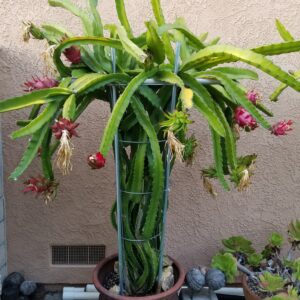Description
The Moses in the Cradle plant, also known as Tradescantia spathacea, is known for its striking appearance and ease of care. Key points about this plant are provided below:
Appearance
- Leaves: Sword-shaped leaves that are green on top and purple underneath are exhibited, creating a beautiful contrast.
- Flowers: Small white flowers nestled in boat-shaped bracts are produced, giving the plant the common name “Moses in the Cradle.”
Care Requirements
- Light: Bright, indirect light is preferred, but lower light conditions can be tolerated. Direct sunlight is known to scorch the leaves.
- Watering: The soil should be kept consistently moist but not waterlogged. The top inch of soil should be allowed to dry out between waterings.
- Soil: A well-draining potting mix is ideal. A standard indoor potting soil with added perlite or sand is often used.
- Temperature: Average indoor temperatures (60-85°F or 15-29°C) are preferred. The plant should be kept away from drafts and cold windows.
- Humidity: Higher humidity levels are preferred, but normal indoor humidity can be adapted to. Misting the plant or placing it near a humidifier can be beneficial.
- Fertilizing: A balanced, water-soluble fertilizer should be used every 4-6 weeks during the growing season (spring and summer).
Propagation
- Division: The most common method. Offsets should be separated from the parent plant and replanted.
- Cuttings: Stem cuttings can be rooted in water or soil.
Common Issues
- Pests: Common pests like spider mites, aphids, and mealybugs should be watched for. Treatment with insecticidal soap or neem oil can be applied if necessary.
- Leaf Browning: Often caused by too much direct sunlight or inconsistent watering.
Benefits
- Air Purification: Like many houseplants, Tradescantia spathacea can help purify indoor air.
- Aesthetic: Its unique foliage adds visual interest to any indoor space.
radescantia spathacea, commonly known as Moses in the Cradle, Oyster Plant, or Boat Lily, boasts a rich botanical history deeply rooted in the tropical and subtropical regions of Central America, particularly from southern Mexico to Guatemala and Belize.
Discovery and Classification
- Early Recognition: Indigenous peoples of Central America were likely the first to recognize and utilize the plant, both for its ornamental beauty and its medicinal properties.
- Botanical Classification: Tradescantia spathacea belongs to the Commelinaceae family, a group known for its many ornamental plants. The genus Tradescantia is named in honor of John Tradescant the Elder and his son, John Tradescant the Younger, who were prominent English naturalists and botanists in the 17th century.
Spread and Cultivation
- Colonial Era: During the colonial era, European explorers and botanists brought specimens of Tradescantia spathacea back to Europe. Its unique appearance and relatively easy cultivation made it a popular addition to botanical gardens and private collections.
- Global Popularity: The plant’s ability to thrive in a variety of conditions facilitated its spread around the world. It became particularly popular in the southeastern United States, the Caribbean, and parts of Asia and Africa.
Horticultural Significance
- Ornamental Use: Tradescantia spathacea is widely grown as an ornamental plant both outdoors in warm climates and indoors as a houseplant. Its distinctive foliage, with green leaves on top and purple underneath, makes it a favorite for adding color and texture to gardens and interiors.
- Medicinal Uses: In its native regions, the plant has been used in traditional medicine. Extracts from the plant are believed to have anti-inflammatory and antimicrobial properties, although these uses are not widely documented in modern scientific literature.
Cultural Impact
- Common Names: The plant’s common name, “Moses in the Cradle,” comes from its boat-shaped bracts that cradle its small white flowers, reminiscent of the biblical story of Moses being placed in a cradle among the reeds.
- Symbolism and Folklore: In various cultures, the plant is associated with protection and good fortune. Its robust nature and vibrant colors symbolize resilience and beauty.
Modern Developments
- Cultivars and Varieties: Several cultivars of Tradescantia spathacea have been developed, featuring variations in leaf coloration and size. These cultivars continue to enhance its popularity among plant enthusiasts.
- Invasive Potential: In some regions, particularly in the southeastern United States and parts of Australia, Tradescantia spathacea has shown invasive tendencies, spreading aggressively in natural areas and outcompeting native vegetation. Efforts to manage its spread are ongoing in these areas.
Tradescantia spathacea’s journey from the tropical regions of Central America to becoming a global horticultural favorite highlights its adaptability and appeal. Its rich history, from indigenous uses to modern ornamental cultivation, underscores its significance in both botanical and cultural contexts. The plant continues to be cherished for its striking appearance and ease of care, making it a staple in gardens and homes worldwide.






Reviews
There are no reviews yet.